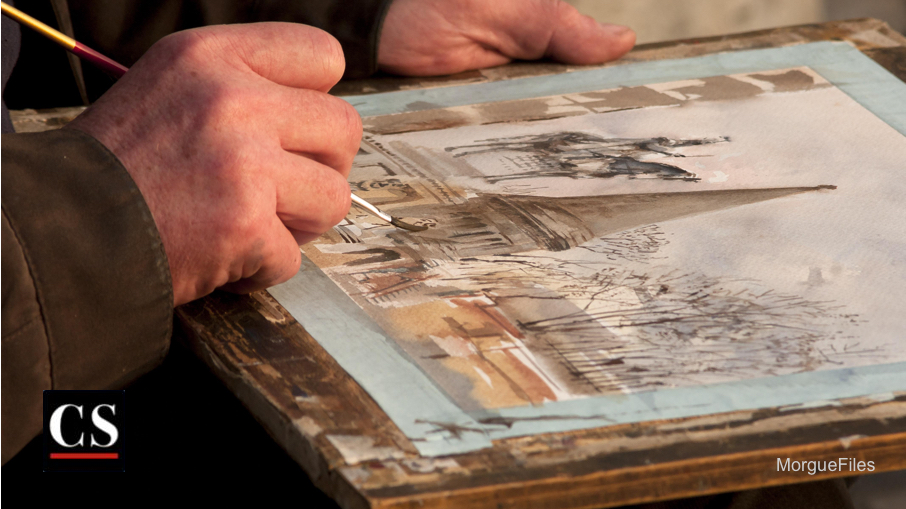There’s nothing too small, I can still find its charm
and paint it in gold and quite big,
I hold it up high without even knowing
whose soul will be fed by it.[1]
I’m continuing the summer series of reflections on the transcendentals as they are brought forth and nourished by artists, intellectuals, and professed religious. This month, the focus is on artists – perhaps the most misunderstood and diminished of the transcendental vocations.
When Pope St. John Paul II wrote his Letter to Artists, he emphasized the distinction between the artist and the task “all men and women are entrusted with… crafting their own life.” While he reminds the reader that “not all are called to be artists” he is not negating the responsibility all men have to be “authors of their own acts, with responsibility for their moral value.”[2] But for the artist, he is adding another responsibility: “to respond to the demands of art and faithfully accept art’s specific dictates.”[3]
The Demands of Art
But what are art’s dictates? What demands are on the artist and his works? St. John Paul II gives us direction here as well:
The artist has a special relationship to beauty… it can be said that beauty is the vocation bestowed on him by the Creator in the gift of “artistic talent”. And, certainly, this too is a talent which ought to be made to bear fruit, in keeping with the sense of the Gospel parable of the talents (cf. Mt 25:14-30).
Here we touch on an essential point. Those who perceive in themselves this kind of divine spark which is the artistic vocation—as poet, writer, sculptor, architect, musician, actor and so on—feel at the same time the obligation not to waste this talent but to develop it, in order to put it at the service of their neighbour and of humanity as a whole.[4]
The demands of art, like the demands of God to the prophets, are to “speak and do not be silent.”[5] Artists must create – like Jeremiah they may say “there is in my heart as it were a burning fire shut up in my bones, and I am weary with holding it in, and I cannot.”[6]
“Society needs artists,” writes St. John Paul II, but often, society doesn’t want artists. Society would much rather focus on the pretty, the flashy, the bright… the palatable. Artists are called to beauty though – to be for society “the necessary other, a reminder and reproach.”[7] Beauty, all too often, is rejected. It’s not pretty or flashy enough. It’s uncomfortable. It stands us in the mirror next to God and all our flaws are obvious. But it is beautiful, if we can look past our own, awkward reflection. Beauty is what makes it possible for “even the work that negates” to still affirm something, and to still do “homage to the wretched and magnificent life that is ours.”[8]
The artist is tasked with birthing forth beauty on the world, holding it up for all to see, and never knowing “whose soul will be fed by it.”
The Call to Art
Such is my daily labor over which
lies my shadow like a shell.
And though I am like leaves and loam,
as often as I pray or paint
it’s Sunday and deep down I am
joyful Jerusalem.[9]
I love watching my husband paint. The colors taking shape under his brushes – hands and eyes and draping fabrics. Wings and stars. Whatever he paints takes on a depth it didn’t have before. Through him I am learning to see the world “gratefully as one big theme.”[10] This past spring he painted an image of Christ and His Sacred Heart. I love this painting in part because of the expression in His eyes. Neither sentimental nor cold, Christ looks out from the image with an expression that reminds me how He looked at the Rich Young Man in Mark’s Gospel. The man who embraced the law and longed for more, but couldn’t quite leap into his full vocation, “Come, follow me.”
In the Gospel, we’re told that “Jesus, looking upon him, loved him.”[11] Pious tradition has always claimed that the Rich Young Man returned, and became St. Mark himself. Perhaps he just needed to know that he was loved beyond his obedience to entrust himself fully to Christ.
That expression of love is the call to the artist as well – Christ “the supremely beautiful” draws the artist along the path “to the inmost reality of man and of the world.” The artist is called both to follow that path and to “paint it in gold and quite big” to that society which needs beauty so that “the knowledge of God can be… revealed.”[12]
The Artist Among Us
We’re uncomfortable with artists these days. There isn’t’ really a place for the artist in society or in the Church. Despite St. John Paul II’s open-hearted letter, the Church continues to under-prioritize beauty and the artists who are called to it.
We’re uncomfortable with the idea of a “called life” in general. “The ideology of our time is that we can live an uncalled life, one not referred to any purpose beyond one’s self.”[13] The truth is, none of us can live an uncalled life. We are all called to something – but some of us are called to more.
If that sounds like God is playing favorites, step back for a second and think of the saints. We’re all called to sainthood, but even among the canonized saints we have an abundance of callings. “Small,” hidden saints like Grwst of Wales and Thérèse of Lisieux are just as beloved by God as Francis of Assisi and Ignatius of Antioch.
Most of us are grateful that we weren’t called to the whole-hearted pursuit of Lady Poverty or to a brutal, public martyrdom. God calls us to the life – and death – that best fits our souls. Those called to art are called to specific Vocations as well: priesthood, religious life, eremitic life, marriage. Whatever his Vocation, the artist can’t abandon his call, it is “a burning fire shut up in [his] bones.”
It is essential for his community to see and value his call. In a culture that swings from romanticizing to dismissing them, “artists soon learn that a strong ego is necessary… they are well served by a level of self-assurance… that others find daunting, and often misread as self-satisfaction.”[14] That means his family and friends, his confessor, and his patrons need to see him as he is. Behind the self-assurance there is a person whose calling is to bare his inmost heart to the world.
When the artist creates beauty, we have to remember he is building from his own life and soul. When it makes us feel, we have to remember that we are feeling around in the soul of another.
Søren Kierkegaard compares the artist to “An unhappy man who hides deep anguish in his heart, but whose lips are so formed that when the sigh and cry pass through them, it sounds like lovely music…. And people flock around the poet and say: ‘Sing again soon’ – that is, ‘May new sufferings torment your soul but your lips be fashioned as before, for the cry would only frighten us, but the music, that is blissful.’”[15]
It’s not that artists are always miserable, but it is true that artists “interact strongly with their world, and that there is a measure of suffering involved as they come to a mature understanding of their communal role.”[16] Their communities should value this. It is not an easy calling, but nourished by a community that believes in his work the artist can truly “see themselves and the whole of creation with eyes able to contemplate and give thanks, and to raise to God a hymn of praise.”[17]
[1] Rilke, Rainer Maria. The Book of Hours. Trans. Annemarie S. Kidder. Northwestern University Press. 2001.
[2] Pope St. John Paul II. Letter to Artists. 1999. Section 2.
[3] Ibid
[4] Pope St. John Paul II. Letter to Artists. 1999. Section 3.
[5] Acts 18:9. Revised Standard Version: Catholic Edition. Ignatius Press. 1966.
[6] Jeremiah 20:9. Revised Standard Version: Catholic Edition. Ignatius Press. 1966.
[7] Norris, Kathleen. The Cloister Walk. Riverhead Books. 1996.
[8] Camus, Albert. Resistance, Rebellion, and Death. Trans. Justin O’ Brien. Vintage International. 1988.
[9] Rilke, Rainer Maria. The Book of Hours. Trans. Annemarie S. Kidder. Northwestern University Press. 2001.
[10] Ibid.
[11] Mark 10:21. Revised Standard Version: Catholic Edition. Ignatius Press. 1966.
[12] Pope John Paul II. Letter to Artists. 1999. Section 11.
[13] Norris, Kathleen. The Cloister Walk. Riverhead Books. 1996.
[14] Ibid.
[15] Kierkegaard, Søren. Either-Or.
[16] Norris, Kathleen. The Cloister Walk. Riverhead Books. 1996.
[17] Pope John Paul II. Letter to Artists. 1999. Section 1.







